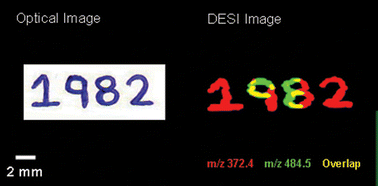Non-destructive Method To Detect Forgery
Posted in Mass Spectrometry on May 06, 2007
 The technique, developed by Graham Cooks at Purdue University, Indiana, and his colleagues, combines 2D molecular imaging with ambient Mass Spectrometry (MS).
The technique, developed by Graham Cooks at Purdue University, Indiana, and his colleagues, combines 2D molecular imaging with ambient Mass Spectrometry (MS).
Presently the majority of document analysis requires parts of the document to be cut up, extracted with solvent then run on chromatographic column followed by Mass Spectrometry (MS).
Cooks’ method uses DESI-MS (Desorption Electrospray Ionization Mass Spectrometry) under ambient conditions, where the analyte is electrosprayed with a solvent to generate charged droplets for MS analysis. This method greatly reduces the number of sample treatment steps and also only damages a smaller amount of document’s surface. The research group was able to use the technique to identify if and where handwritten text had been altered.
“The use of DESI and imaging DESI for the forensic analysis of inks represents an exciting new application of the technique” said Colin Creaser, professor of analytical chemistry at Nottingham Trent University, UK. In addition, the 2D imaging aspect of the technique means that the analysis can be highly targeted, generating position-specific mass spectra. Cooks and his team believe that this technique has huge potential.
Reference: “Forensic analysis of inks by imaging desorption electrospray ionization (DESI) mass spectrometry”
D. R. Ifa, L. M. Gumaelius, L. S. Eberlin, N. E. Manicke and R. G. Cooks, Analyst, 2007
DOI: 10.1039/b700236jAbstract: Desorption electrospray ionization mass spectrometry (DESI-MS) is employed in the forensic analysis of documents. Blue ballpoint pen inks applied to ordinary writing paper are examined under ambient conditions without any prior sample preparation. When coupled to an automated moving stage, two-dimensional molecular images are generated. Proof-of-principle experiments include characterization of a simulated forged number and examination of older written records. This application of DESI has advantages over extractive techniques in terms of speed and sample preservation. The effects of the desorbing solvent composition, in this case a mixture of methanol and water, and of flow rate, are evaluated. Results suggest that the solubility of the analyte (dyes Basic Blue 7, Basic Violet 3 and Solvent Blue 26) plays an important role in desorption from the paper surface.
2 Responses to “Non-destructive Method To Detect Forgery”
Leave a Reply
Tag Cloud
-
adsorbent
benzene
china
chlorophyll
chromatographic
chromatography
column chromatography
CZE
DESI
electromagnetic induction
electrospray
ELISA
eluent
explosives
forensic
furosine
Gas Chromatography
GC/MS
History
HPLC
IC
isoflavones
lab-on-a-chip
LCMS
maldi tof
Mass Spectrometry
microfluidic
nano
Nano HPLC
nanoliquid
nanoscale
nanostream
nanotechnology
nanotubes
News
organic molecule
protein
Rickettsia
rmsf
rocky mountain spotted fever
science
soy
TCM
ticks
tsvet



Here’s an earlier article using a different open-air ion source:
â??Differentiating Writing Inks Using Direct Analysis in Real Time Mass Spectrometry.â? Roger W. Jones; Robert B. Cody.; John F. McClelland, Journal of Forensic Science, July 2006, Vol. 51, No. 4, pages 915-918
This shows dyes, but also ink lubricants and other fingerprint compounds in ballpoint pen inks. I just visited Ames Lab recently and Roger Jones has been able to show how to detect the AGE of a signature from the DART spectrum. It’s nice work. He’s writing the article.
The article that you might be looking for is: https://lib.dr.iastate.edu/cgi/viewcontent.cgi?article=1238&context=ameslab_pubs